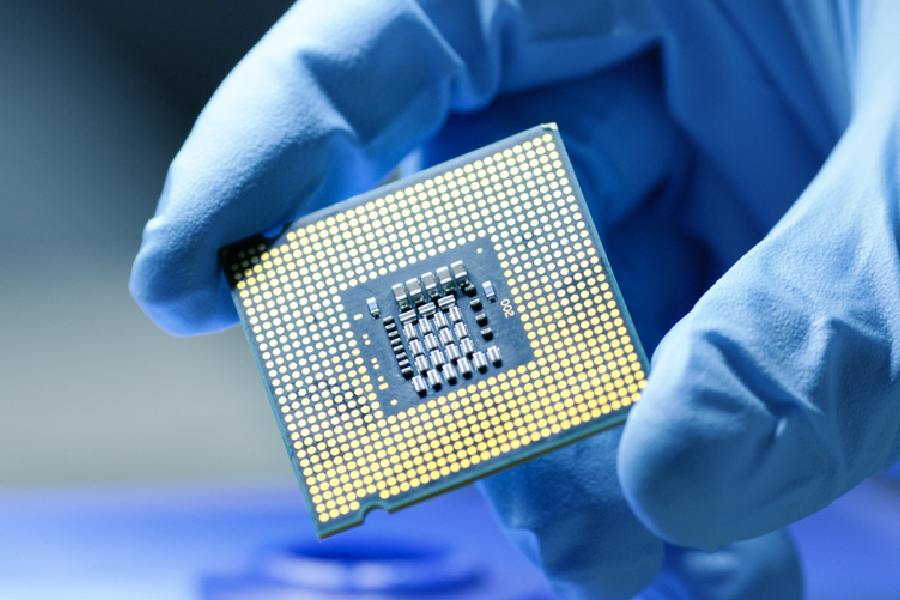Cluster development holds the key to the growth of the semiconductor sector in India as the industry seeks another round of fiscal support under the semiconductor mission.
In 2021, the Union cabinet had approved the programme for the development of semiconductors and display manufacturing ecosystem in India with an outlay of ₹76,000 crore ($10 billion).
The industry now wants support of a size equivalent to or more than the support in the first phase.
The Centre has already committed ₹70,000 crore of the Round 1 support, S. Krishnan, secretary, Union ministry of electronics and information technology (MeitY), had said in July.
Ashok Chandak, president of the India Electronics & Semiconductor Association (IESA), said there was a need for continued stimulus to attract more companies in the FAB (fabrication) and ATMP (Assembly, Testing, Marking, and Packaging) segments to meet both domestic demand and tap export potential.
“The extension of capital outlay under the Semicon India programme is critical for the country to fully capitalise on the growth opportunities in the semiconductor industry. With almost the entire original budget tied up, additional funding is necessary to continue attracting global players, expand domestic capabilities, foster innovation and meet the growing demand for semiconductors across industries.”
“A larger capital outlay will enable India to realise its ambition of becoming a global semiconductor powerhouse while securing its position in an increasingly competitive and geopolitically sensitive sector,” said Chandak.
“We have done silicon but not compound semiconductors as yet. In addition to that, there is a need to create the ecosystem as well and they should also be given incentives to set up so that they are closer to the fab plants that are being set up,” said Ajai Chowdhry, co-founder HCL and chairman EPIC Foundation.
While elemental semiconductors are formed from single chemical elements such as silicon and germanium, compound semiconductors are formed as a result of the chemical reaction between two or more different elements (examples include gallium arsenide, indium arsenide, indium phosphide and gallium nitride).
“There is a lot yet to happen in terms of what we need to do. There should be at least two big silicon fabs, two compound semiconductor plants and at least one display fab,” Chowdhry said.
“Semiconductor manufacturing and assembly isa capital-intensive industry. At its core, the technology involved in manufacturing changes rapidly and thenode sizes are critical to the investments. India will have demand at various nodesizes. The outlay should be expanded keeping the demand and technology insynchronisation,” said Narendra Bhandari, general partner, Seafund.
Multiple benefits
Currently semiconductor projects — both fabrication and testing & assembly — are taking off in Gujarat and Assam but other states are also vying for investments in the sector. However, the industry expects fabrication units to be more efficient when developed in clusters.
“If we look at Hsinchu Science Park in Taiwan which is home to the biggest chip players or the recently announced integrated circuit design park at Puchong in Malaysia, the industry grows as clusters,” said Satya Gupta, president VLSI Society of India, who was in Calcutta last week.
“Typically, design activity can be spread across thecountry. But, manufacturing has to be in clusters. Clustering semiconductor manufacturing in a specific arearather than distributing it across a whole country offers several advantages —economies of scale, skilled workforce, supply chainefficiency, supportive ecosystem, government support on infrastructure such aswater, power etc,” saidChandak.
“There are a large number of requirements such as gases, chemicals, clean rooms, etc. which are needed and it is difficult to spread these across the country on Day One. These factors make clustering a more effective strategy for semiconductor manufacturing,” he said.
Industry prospects
As per industry estimate, the size of the Indian semiconductor market is expected to reach $109 billion by 2030.
“IESA has done a detailed market study and came up with these numbers. The electronics market is expected to be $450-500 billion by 2030 considering the domestic demand and exports potential. And correspondingly, semiconductor demand will increase to $100 billion-plus by 2030,” said Chandak.
“Semiconductor technology is required today in various areas of consumer lifestyle, business operations, armed forces, government infrastructure, environmental monitoring and protection, transport, space technology and many more areas,” said Bhandari.
“Not all of the sectors require the most advanced manufacturing capabilities. National security and privacy will also continue to play an important role in the semiconductor investment decisions,” he said.
But concurrent to the development of semiconductor fabrication and packaging, a domestic consumer base of the chips made in India is also required, said Chowdhry.
“There is a very large missing piece today — who will be the customer of the fabs? Today most of the dependance of fabs will be on exports. If we produce products that are designed in India, then we will have fab customers in India,” he said.
Homegrown interest
Chandak said that there is a rising interest among homegrown players to invest in the semiconductor industry.
“We need more homegrown players and manycompanies are showing an interest to invest. For example Kaynes, RRP Electronics,CG Power, Zoho, HCL, RIRand many more.”
He said that notable among the ecosystem is Tessolve Semiconductors based in Bangalore, which has become the world’s largest independent semiconductor test company, which was set up two decades ago and growing fast.
“But, these homegrown companies would need strong technology partners to achieve the right processes and technology for manufacturing,” he said.











